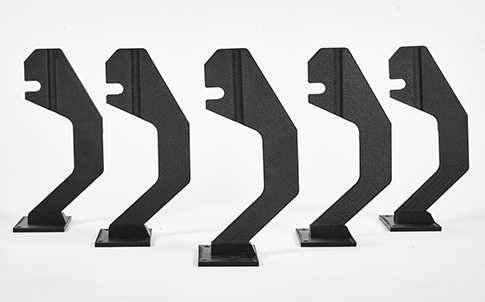Visual First helps The Chocolate Factory prevent bottlenecks with on-demand production parts.
“Additive manufacturing offers significant opportunities to decrease spare-part inventory, reduce the supply chain, and slash costs. The ability to print a spare part on-demand offers manufacturers a rapid solution that ensures production continuity and, most importantly, help safeguard revenues.” – Carl van de Rijzen, Visual First
Carl van de Rijzen founded Visual First back in 2006. The company provides many chocolate products, including the Dutch favourite, Johnny Doodle. The chocolate factory needed a cheaper alternative to its mostly packaging and lengthy lead times waiting for replacement parts.
The Chocolate Factory’s difficult packaging machines rely on the smooth operation of a simple, yet extremely important, hook-shaped metal part that lifts wrapped chocolate bars onto a conveyor belt. Because of different product sizes, the machines need regular adjustments, posing two challenges.
If the hook-shaped part is not inserted into the machine properly, it jams and requires immediate replacement
There’s a constant need for human intervention and maneuvering of metal parts ends in damage to the machine
Carbon-Fiber 3D Printed Thermoplastic Replaces Metal Production Part
The requirements were made very clear with Visual First. The chocolate Factory needed a replacement part that was strong and reliable, and that could be produced quickly. Visual First tested many designs using SLS and SLA technologies. “Unfortunately, for the factory’s requirements, the first prototypes were not strong enough to withstand the force of the machine,” said van de Rijzen.
The company then turned to Stratasys’ high-performance FDM Nylon 12CF™, a carbon fiber thermoplastic. It produced on the Stratasys Fortus 450mc™ 3D printer. The final printed parts high stiffness-to-weight ratio and extreme rigidity was exactly what The Chocolate Factory required.
“The success of the part was instantly clear; the material is impossible to bend,” van de Rijzen said. “The part withstood all tests on the machine and multiple runs were completed without incident. The factory increased production throughput by replacing the metal machine part with our 3D printed version.”

Time and Cost Efficiencies
With machines needing high levels of customization, the requirement for advanced material capabilities was not van de Rijzen’s only concern. The existing metal part was malfunctioning with such regularity it required replacement up to three times a month. As each part must be handmade using traditional means, replacing these via suppliers took over a month. A time frame that posed a huge problem for the factory team.
“Considering the essential role of this part, it is crucial that a spare part is available on demand to ensure the packaging machine is always operational,” said van de Rijzen. “With the Stratasys Fortus 450mc, we have a rapid, high-throughput solution that delivers highly accurate and repeatable results. As a result, the downtime on these parts is dramatically reduced. The Chocolate Factory can now have replacement parts manufactured and delivered in under a week, which is instrumental to its business continuity.”
Switching to 3D printing also resulted in 60% savings in cost on the part. “The ability to optimize the design with our 3D printer has improved the actual functionality of the part on the machine,” van de Rijzen added.
Continued Calibration
The Chocolate Factory continuously uses Visual First in order to solve other design challenges.Most distinctly, developing a casting mold prototype to test product acceptance. The casting mold is now made from plastic using traditional methods, which is time consuming and expensive.
“Additive manufacturing offers significant opportunities to decrease spare-part inventory, reduce the supply chain and slash costs. The ability to print a spare parts on-demand offers manufacturers a rapid solution that ensures production continuity and, most importantly, help safeguard revenues,” said van de Rijzen